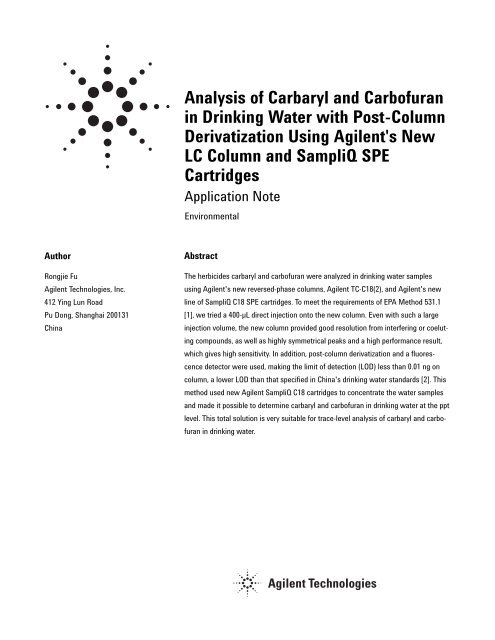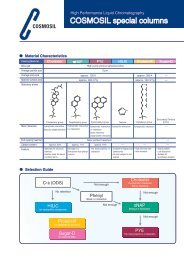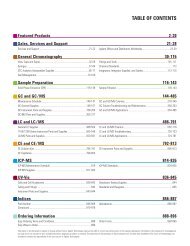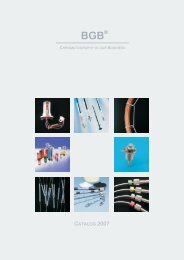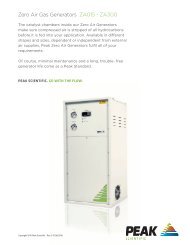Analysis of Carbaryl and Carbofuran in Drinking ... - BGB Analytik AG
Analysis of Carbaryl and Carbofuran in Drinking ... - BGB Analytik AG
Analysis of Carbaryl and Carbofuran in Drinking ... - BGB Analytik AG
You also want an ePaper? Increase the reach of your titles
YUMPU automatically turns print PDFs into web optimized ePapers that Google loves.
Author<br />
Rongjie Fu<br />
Agilent Technologies, Inc.<br />
412 Y<strong>in</strong>g Lun Road<br />
Pu Dong, Shanghai 200131<br />
Ch<strong>in</strong>a<br />
<strong>Analysis</strong> <strong>of</strong> <strong>Carbaryl</strong> <strong>and</strong> Carb<strong>of</strong>uran<br />
<strong>in</strong> Dr<strong>in</strong>k<strong>in</strong>g Water with Post-Column<br />
Derivatization Us<strong>in</strong>g Agilent's New<br />
LC Column <strong>and</strong> SampliQ SPE<br />
Cartridges<br />
Application Note<br />
Environmental<br />
Abstract<br />
The herbicides carbaryl <strong>and</strong> carb<strong>of</strong>uran were analyzed <strong>in</strong> dr<strong>in</strong>k<strong>in</strong>g water samples<br />
us<strong>in</strong>g Agilent's new reversed-phase columns, Agilent TC-C18(2), <strong>and</strong> Agilent's new<br />
l<strong>in</strong>e <strong>of</strong> SampliQ C18 SPE cartridges. To meet the requirements <strong>of</strong> EPA Method 531.1<br />
[1], we tried a 400-µL direct <strong>in</strong>jection onto the new column. Even with such a large<br />
<strong>in</strong>jection volume, the new column provided good resolution from <strong>in</strong>terfer<strong>in</strong>g or coelut<strong>in</strong>g<br />
compounds, as well as highly symmetrical peaks <strong>and</strong> a high performance result,<br />
which gives high sensitivity. In addition, post-column derivatization <strong>and</strong> a fluorescence<br />
detector were used, mak<strong>in</strong>g the limit <strong>of</strong> detection (LOD) less than 0.01 ng on<br />
column, a lower LOD than that specified <strong>in</strong> Ch<strong>in</strong>a's dr<strong>in</strong>k<strong>in</strong>g water st<strong>and</strong>ards [2]. This<br />
method used new Agilent SampliQ C18 cartridges to concentrate the water samples<br />
<strong>and</strong> made it possible to determ<strong>in</strong>e carbaryl <strong>and</strong> carb<strong>of</strong>uran <strong>in</strong> dr<strong>in</strong>k<strong>in</strong>g water at the ppt<br />
level. This total solution is very suitable for trace-level analysis <strong>of</strong> carbaryl <strong>and</strong> carb<strong>of</strong>uran<br />
<strong>in</strong> dr<strong>in</strong>k<strong>in</strong>g water.
Introduction<br />
<strong>Carbaryl</strong> <strong>and</strong> carb<strong>of</strong>uran are N-methyl carbamate pesticides<br />
(structure shown <strong>in</strong> Figure 1), which are classified as broadspectrum<br />
<strong>in</strong>secticides <strong>and</strong> are mostly used on rice <strong>and</strong> corn<br />
crops. Excess pesticide can contam<strong>in</strong>ate ground water, surface<br />
water, <strong>and</strong> dr<strong>in</strong>k<strong>in</strong>g water. Because this k<strong>in</strong>d <strong>of</strong> pesticide<br />
has been shown to create health problems with blood <strong>and</strong><br />
with the nervous <strong>and</strong> reproductive systems, actions have<br />
been taken to control these compounds <strong>and</strong> require that their<br />
amounts be measured <strong>in</strong> dr<strong>in</strong>k<strong>in</strong>g water.<br />
Regulatory methods are set <strong>in</strong> many countries. The Ch<strong>in</strong>a<br />
dr<strong>in</strong>k<strong>in</strong>g water st<strong>and</strong>ards published <strong>in</strong> 2006 restrict the maximum<br />
limit <strong>of</strong> carb<strong>of</strong>uran <strong>in</strong> dr<strong>in</strong>k<strong>in</strong>g water to 7 ppb <strong>and</strong> use<br />
liquid-liquid extraction to test the water samples. The U.S.<br />
Environmental Protection Agency (EPA) Method 531.1 sets<br />
the maximum contam<strong>in</strong>ation level (MCL) at 40 ppb <strong>and</strong> uses<br />
direct aqueous <strong>in</strong>jection [1]. Each method has its own disadvantages.<br />
Liquid-liquid extraction is laborious, time-consum<strong>in</strong>g<br />
work that requires a large amount <strong>of</strong> organic solvents.<br />
Direct aqueous <strong>in</strong>jection is a simple method with less <strong>in</strong>terferential<br />
peaks; however, it is not suitable for measur<strong>in</strong>g<br />
lower levels <strong>of</strong> compounds <strong>in</strong> dr<strong>in</strong>k<strong>in</strong>g water.<br />
Solid-phase extraction (SPE) is <strong>of</strong>ten used for the enrichment<br />
<strong>of</strong> water samples. This process is typically done us<strong>in</strong>g a st<strong>and</strong>ard<br />
SPE vacuum manifold but can be easily automated for<br />
the enhanced sensitivity required to measure low-level<br />
organic compounds <strong>in</strong> dr<strong>in</strong>k<strong>in</strong>g water.<br />
This application note describes an improved method for determ<strong>in</strong><strong>in</strong>g<br />
low levels <strong>of</strong> carbaryl <strong>and</strong> carb<strong>of</strong>uran <strong>in</strong> dr<strong>in</strong>k<strong>in</strong>g water.<br />
The method applies an automated procedure <strong>of</strong> sample concentration<br />
<strong>and</strong> post-column derivatization to successfully<br />
measure carbaryl <strong>and</strong> carb<strong>of</strong>uran <strong>in</strong> dr<strong>in</strong>k<strong>in</strong>g water at the ppt<br />
level. New Agilent SampliQ C18 SPE cartridges were used for<br />
sample enrichment from water. The sample was then analyzed<br />
with Agilent TC-C18(2) columns, which provide symmetrical<br />
peak shape <strong>and</strong> high sensitivity. Last, the separated compounds<br />
were derivatizated before detection with a fluorescence<br />
detector. The derivatization reaction is shown <strong>in</strong><br />
Figure 2. <strong>Carbaryl</strong> <strong>and</strong> carb<strong>of</strong>uran are first hydrolyzed under<br />
basic conditions at high temperature <strong>in</strong>to methylam<strong>in</strong>e <strong>and</strong><br />
then react with o-phthalaldehyde (OPA) <strong>and</strong> 2-mercaptoethanol<br />
<strong>in</strong>to iso<strong>in</strong>dole, which has strong fluorescence. This is a simple,<br />
automated, fast, <strong>and</strong> high recovery method that is fit for<br />
quality control <strong>of</strong> dr<strong>in</strong>k<strong>in</strong>g water.<br />
2<br />
O<br />
O<br />
N H<br />
Experimental<br />
Instruments<br />
O<br />
HN<br />
O O<br />
<strong>Carbaryl</strong> Carb<strong>of</strong>uran<br />
Figure 1. Structures <strong>of</strong> carbaryl <strong>and</strong> carb<strong>of</strong>uran.<br />
O<br />
<strong>Carbaryl</strong><br />
O<br />
O<br />
HN<br />
N H<br />
O O<br />
Carb<strong>of</strong>uran<br />
Nonfluorescent<br />
OH _<br />
95 °C<br />
CH 3 NH<br />
2<br />
+ RSH <strong>and</strong><br />
Room temperature<br />
Figure 2. Derivatization reaction <strong>of</strong> carbaryl <strong>and</strong> carb<strong>of</strong>uran.<br />
O<br />
O<br />
H<br />
H<br />
SR<br />
N<br />
Strong<br />
fluorescent<br />
HPLC Conditions<br />
Instrument Agilent 1100 or 1200 with fluorescence<br />
detector (FLD): A multidraw upgrade kit<br />
(p/n G1313-68711) can be <strong>in</strong>stalled when<br />
400-µL <strong>in</strong>jections are needed.<br />
Column Agilent TC-C18(2) 4.6 × 150 mm, 5 µm<br />
(p/n 588935-902)<br />
Mobile phase A: Water, B: Methanol<br />
0 m<strong>in</strong> 42% B, 5 m<strong>in</strong> 55% B, 12 m<strong>in</strong> 60% B,<br />
13 m<strong>in</strong> 42% B, stop time 15 m<strong>in</strong>, post-run 2 m<strong>in</strong><br />
Flow rate 1.0 mL/m<strong>in</strong><br />
Column temperature 30 °C<br />
FLD detector Ex 339 nm; Em 445 nm<br />
Injection volume 10 µL<br />
P<strong>in</strong>nacle PCX Picker<strong>in</strong>g Laboratories, Inc.<br />
derivatization <strong>in</strong>strument<br />
Post-Column Reaction Conditions<br />
Flow rate <strong>of</strong> reagents 0.1 mL/m<strong>in</strong><br />
Reactor temperature 95 °C<br />
Derivatization temperature Room temperature<br />
Caliper LS Autotrace SPE Caliper Life Sciences, Inc.<br />
Workstation<br />
SPE Cartridges Agilent SampliQ C18, 6ml/500mg (p/n 5982-1165)<br />
Technologies, Inc.<br />
TurboVap II Evaporation Caliper Life Sciences, Inc.<br />
System
St<strong>and</strong>ards for Calibration Curves<br />
Accurately weigh 10 mg <strong>of</strong> carb<strong>of</strong>uran <strong>and</strong> 12.2 mg <strong>of</strong> carbaryl<br />
st<strong>and</strong>ards <strong>and</strong> separately dissolve <strong>in</strong> methanol to a volume <strong>of</strong><br />
10 mL. Make the stock solution by mix<strong>in</strong>g 60 µL <strong>of</strong> the carb<strong>of</strong>uran<br />
<strong>and</strong> 40 µL <strong>of</strong> the carbaryl solutions <strong>in</strong>to a 10 mL volumetric<br />
flask. Dilute to volume with methanol to obta<strong>in</strong> a concentration<br />
<strong>of</strong> 4.88 µg/mL <strong>of</strong> carbaryl <strong>and</strong> 6.0 µg/mL <strong>of</strong> carb<strong>of</strong>uran.<br />
Dilute aliquots <strong>of</strong> the stock st<strong>and</strong>ard solution with<br />
methanol <strong>in</strong>to a series <strong>of</strong> st<strong>and</strong>ard solutions shown <strong>in</strong> Table 1.<br />
Table 1. St<strong>and</strong>ard Solutions for Calibration Curves<br />
Level 1 2 3 4 5<br />
<strong>Carbaryl</strong> (ppb) 48.8 97.6 244.0 488.0 976.0<br />
Carb<strong>of</strong>uran (ppb) 60.0 120 300.0 600.0 1200<br />
Derivatization Reagents<br />
Sodium hydroxide 0.05 N – Dissolve 2.0 g <strong>of</strong> sodium hydroxide<br />
(NaOH) <strong>in</strong> reagent water. Dilute to 1.0 L with<br />
reagent water. Filter <strong>and</strong> degas just before use.<br />
Mercaptoethanol (1+1) Mix 10.0 mL <strong>of</strong> 2-mercaptoethanol <strong>and</strong> 10.0 mL<br />
<strong>of</strong> acetonitrile. Cap. Store <strong>in</strong> hood.<br />
Sodium borate 0.05 N – Dissolve 19.1 g <strong>of</strong> sodium borate<br />
(Na2B407·10H2O) <strong>in</strong> reagent water. Dilute to<br />
1.0 L with reagent water. The sodium borate<br />
will completely dissolve at room temperature if<br />
prepared a day before use.<br />
OPA reaction solution Dissolve 100 ± 10 mg <strong>of</strong> o-phthalaldehyde<br />
(melt<strong>in</strong>g po<strong>in</strong>t = 55 to 58 °C) <strong>in</strong> 10 mL <strong>of</strong><br />
methanol. Add to 1.0 L <strong>of</strong> 0.05 N sodium borate.<br />
Mix, filter, <strong>and</strong> degas. Add 100 µL <strong>of</strong><br />
2-mercaptoethanol (1 + 1) <strong>and</strong> mix. Make up<br />
fresh solution daily.<br />
Other reagents<br />
Methanol HPLC grade<br />
Water Milli-Q water as mobile phase <strong>and</strong> reagent<br />
water; tap water as sample<br />
Acetic acid AR grade<br />
Sodium thiosulfate AR grade<br />
Dichloromethane HPLC grade<br />
Sample Preparation Method<br />
We used an automated SPE workstation for sample preparation<br />
<strong>in</strong>stead <strong>of</strong> traditional liquid-liquid extraction <strong>in</strong> Ch<strong>in</strong>a<br />
dr<strong>in</strong>k<strong>in</strong>g water st<strong>and</strong>ard. Before extraction with SPE, acetic<br />
acid was added to the water sample to a concentration <strong>of</strong><br />
0.1%. If tap water is used, sodium thiosulfate should be also<br />
added to a concentration <strong>of</strong> 80 mg/L.<br />
3<br />
The SPE extraction procedure is as follows:<br />
1. Wash syr<strong>in</strong>ge with 5.0 mL <strong>of</strong> CH2CL2 .<br />
2. Condition cartridge with 5.0 mL <strong>of</strong> CH2CL2 <strong>in</strong>to solvent<br />
waste.<br />
3. Wash syr<strong>in</strong>ge with 5.0 mL <strong>of</strong> methanol.<br />
4. Condition cartridge with 5.0 mL <strong>of</strong> methanol <strong>in</strong>to solvent<br />
waste.<br />
5. Condition cartridge with 5.0 mL <strong>of</strong> reagent water <strong>in</strong>to<br />
aqueous waste.<br />
6. Load 1,000.0 mL (1 L) <strong>of</strong> sample onto column.<br />
7. R<strong>in</strong>se cartridge with 5.0 mL <strong>of</strong> reagent water <strong>in</strong>to<br />
aqueous waste.<br />
8. Dry cartridge with N2 for 10 m<strong>in</strong>utes.<br />
9. Wash syr<strong>in</strong>ge with 5.0 mL <strong>of</strong> CH2CL2 .<br />
10. Soak for two m<strong>in</strong>utes with 5.0 mL CH2CL2 <strong>and</strong> collect the<br />
eluent.<br />
11. Repeat step 10.<br />
12. Collect 5.0-mL fractions <strong>in</strong>to sample tube us<strong>in</strong>g air.<br />
13. Evaporate the eluted sample with a stream <strong>of</strong> N2 to a<br />
volume <strong>of</strong> 0.5 mL.<br />
14. Inject 10 µL <strong>in</strong>to HPLC for analysis.<br />
Flow Rates Set<br />
Condition flow 1.0 mL/m<strong>in</strong><br />
Load flow 5.0 mL/m<strong>in</strong><br />
R<strong>in</strong>se flow 1.0 mL/m<strong>in</strong><br />
Elute flow 1.0 mL/m<strong>in</strong><br />
Condition air push 15.0 mL/m<strong>in</strong><br />
R<strong>in</strong>se air push 10.0 mL/m<strong>in</strong><br />
Elute air push 5.0 mL/m<strong>in</strong><br />
If you do not have an automated SPE workstation, an Agilent<br />
vacuum manifold (p/n 5182-9110 or 5182-9120) is recommended.<br />
To automatically pull the water sample through,<br />
attach an adapter (p/n 5182-9109) with a pipe onto the SPE<br />
cartridge. The water sample should be pulled through the SPE<br />
by vacuum at the flow rate <strong>of</strong> no more than 5 mL/m<strong>in</strong> for<br />
good recovery.
Results <strong>and</strong> Discussion<br />
Separation<br />
The st<strong>and</strong>ard solutions were analyzed by <strong>in</strong>ject<strong>in</strong>g 10 µL <strong>of</strong><br />
each <strong>of</strong> the st<strong>and</strong>ard solutions onto the Agilent TC-C18(2)<br />
column. The chromatograms from the st<strong>and</strong>ard <strong>in</strong>jections<br />
(Figure 3) show high performance, high resolution, <strong>and</strong> symmetrical<br />
peaks. We have also run this on an HC-C18(2) column.<br />
A little longer retention was achieved with almost the<br />
same performance as with the TC-C18(2) column. These<br />
columns have a different carbon load: 17 percent for the<br />
HC-C18(2) column <strong>and</strong> 12 percent for the TC-C18(2) column.<br />
These differences impact retention, with the HC-C18(2) column<br />
typically reta<strong>in</strong><strong>in</strong>g nonpolar <strong>and</strong> moderately polar compounds<br />
more when compared with the TC-C18(2) column. We<br />
prefer the column provid<strong>in</strong>g a shorter analysis time but resolv<strong>in</strong>g<br />
all the peaks. Although both columns are suitable for this<br />
method, we chose the TC-C18(2) because it provided a slightly<br />
shorter analysis time.<br />
LU<br />
4.5<br />
4.0<br />
3.5<br />
3.0<br />
2.5<br />
2.0<br />
1.5<br />
1.0<br />
0.5<br />
Carb<strong>of</strong>uran<br />
4.88 ng<br />
<strong>Carbaryl</strong><br />
6.0 ng<br />
0 2 4 6 8 10 12<br />
Figure 3. Chromatogram <strong>of</strong> carb<strong>of</strong>uran <strong>and</strong> carbaryl st<strong>and</strong>ards on Agilent TC-C18(2),<br />
4.6 × 150 mm, 5 µm columns.<br />
L<strong>in</strong>earity, Reproducibility, <strong>and</strong> Limit <strong>of</strong> Detection<br />
The calibration curves result<strong>in</strong>g from these st<strong>and</strong>ard <strong>in</strong>jections<br />
on the TC-C18(2) column are shown <strong>in</strong> Figure 4. The<br />
method shows excellent l<strong>in</strong>earity, be<strong>in</strong>g very close to 1.0<br />
(0.9997). To evaluate the reproducibility <strong>of</strong> this method on the<br />
TC-C18(2) column, two concentrations <strong>of</strong> carb<strong>of</strong>uran <strong>and</strong> carbaryl<br />
were each <strong>in</strong>jected 10 times. The reproducibility <strong>of</strong> the<br />
peak areas is shown <strong>in</strong> Table 2; the absolute peak area reproducibility<br />
is superior. The average relative st<strong>and</strong>ard deviation<br />
(RSD) is below 3 percent. We calculate the LOD from the<br />
level 1 st<strong>and</strong>ard with a signal-to-noise ratio <strong>of</strong> 3. The LOD is<br />
0.066 ng for carb<strong>of</strong>uran <strong>and</strong> 0.080 ng for carbaryl, which is<br />
three to four times better than the 0.25 ng that is regulated by<br />
Ch<strong>in</strong>a's dr<strong>in</strong>k<strong>in</strong>g water st<strong>and</strong>ard.<br />
m<strong>in</strong><br />
4<br />
Area<br />
80<br />
60<br />
40<br />
20<br />
0<br />
Area<br />
70<br />
60<br />
50<br />
40<br />
30<br />
20<br />
10<br />
0<br />
0<br />
0<br />
1 2<br />
1 2<br />
Carb<strong>of</strong>uran, FLD1 A<br />
Area = 7.38558201*Amt + 0<br />
Rel. Res%(4): 3.286<br />
3<br />
5<br />
Amount[ng]<br />
<strong>Carbaryl</strong>, FLD1 A<br />
Area = 6.73870683*Amt + 0<br />
Rel. Res%(1): _ 3.824<br />
3<br />
Table 2. Reproducibility <strong>of</strong> St<strong>and</strong>ards Injections<br />
4<br />
4<br />
10<br />
5<br />
Correlation: 0.99975<br />
5 10<br />
Amount[ng]<br />
5<br />
Correlation: 0.99974<br />
Figure 4. Calibration curves <strong>of</strong> carb<strong>of</strong>uran <strong>and</strong> carbaryl [Agilent TC-C18(2),<br />
4.6 × 150 mm, 5 µm columns].<br />
RSD (%) n = 10 RSD (%) n = 10<br />
Carb<strong>of</strong>uran 48.8 ppb Carb<strong>of</strong>uran 488 ppb<br />
Analyte <strong>Carbaryl</strong> 60.0 ppb <strong>Carbaryl</strong> 600 ppb<br />
Carb<strong>of</strong>uran 2.3 1.6<br />
<strong>Carbaryl</strong> 1.8 1.5<br />
Recovery<br />
Two different levels were spiked <strong>in</strong> reagent water <strong>and</strong> tap<br />
water, respectively, <strong>and</strong> then followed the sample preparation<br />
procedure. The recovery data are good, with a typical recovery<br />
<strong>in</strong> the range <strong>of</strong> 80 to 110 percent (Table 3).<br />
To better match the Ch<strong>in</strong>a dr<strong>in</strong>k<strong>in</strong>g water method, <strong>in</strong> which<br />
dichloromethane is used for liquid-liquid extraction, we chose<br />
dichloromethane as the SPE cartridge eluent. That provided us<br />
clean chromatograms.
It has been reported that the two compounds are not stable<br />
under neutral <strong>and</strong> basic conditions. [1,3] So the water samples<br />
were stabilized by the addition <strong>of</strong> 0.1 percent acetic acid.<br />
Accord<strong>in</strong>g to the Ch<strong>in</strong>a dr<strong>in</strong>k<strong>in</strong>g water regulatory method, the<br />
residual chlor<strong>in</strong>e present <strong>in</strong> tap water may result <strong>in</strong> low recovery,<br />
thus sodium thiosulfate should be added to the tap water<br />
to elim<strong>in</strong>ate the residual chlor<strong>in</strong>e. We therefore compared the<br />
recovery <strong>of</strong> the tap water with <strong>and</strong> without sodium thiosulfate.<br />
The recovery values obta<strong>in</strong>ed without sodium thiosulfate<br />
were significantly lower than those with sodium thiosulfate.<br />
Therefore, to get good recovery values, we added 80 mg/L <strong>of</strong><br />
sodium thiosulfate to the tap water sample.<br />
Table 3. Recovery for Carb<strong>of</strong>uran <strong>and</strong> <strong>Carbaryl</strong> from Tap Water <strong>and</strong> Reagent Water<br />
Tap water Tap water Pure water Pure water<br />
Spiked level R (%) RSD (%) R (%) RSD (%)<br />
Analyte (ppb) n = 6 n = 6 n = 3 n = 3<br />
Carbafuran 0.1 107.8 13.5 84.4 9.5<br />
0.5 98.8 9.2 98.1 6.8<br />
<strong>Carbaryl</strong> 0.084 87.0 10.1 83.7 6.2<br />
0.41 91.8 9.6 94.3 3.3<br />
The chromatograms <strong>of</strong> reagent water <strong>and</strong> tap water <strong>and</strong> their<br />
spiked samples are shown <strong>in</strong> Figures 5 <strong>and</strong> 6. All the potential<br />
<strong>in</strong>terfer<strong>in</strong>g compounds <strong>in</strong> reagent <strong>and</strong> tap water are well separated<br />
from the target compounds, demonstrat<strong>in</strong>g good<br />
method selectivity.<br />
LU<br />
6<br />
5<br />
4<br />
3<br />
2<br />
1<br />
LU<br />
6<br />
5<br />
4<br />
3<br />
2<br />
1<br />
Blank sample<br />
0 2 4 6 8 10 12 14 m<strong>in</strong><br />
Spiked sample<br />
Carb<strong>of</strong>uran: 0.41 ppb<br />
<strong>Carbaryl</strong>: 0.50 ppb spiked<br />
0 2 4 6 8 10 12 14 m<strong>in</strong><br />
Figure 5. Chromatograms <strong>of</strong> reagent water <strong>and</strong> its spiked sample [Agilent TC-C18(2),<br />
4.6 × 150 mm, 5 µm columns].<br />
5<br />
LU<br />
8<br />
6<br />
4<br />
2<br />
0<br />
0 2 4 6 8 10 12 14 m<strong>in</strong><br />
LU<br />
8<br />
6<br />
4<br />
2<br />
Blank sample<br />
Spiked sample<br />
Carb<strong>of</strong>uran: 0.41 ppb<br />
<strong>Carbaryl</strong>: 0.50 ppb spiked<br />
0<br />
0 2 4 6 8 10 12 14 m<strong>in</strong><br />
Figure 6. Chromatograms <strong>of</strong> tap water <strong>and</strong> its spiked sample [TC C18(2),<br />
4.6 × 150 mm, 5 µm columns].<br />
Direct Injection<br />
A large-volume 400-µL direct <strong>in</strong>jection was applied as<br />
described <strong>in</strong> EPA Method 531.1. We tried a 400-µL <strong>in</strong>jection<br />
by us<strong>in</strong>g the multidraw attachment on the LC <strong>and</strong> the<br />
TC-C18(2) column. The column has a large surface area<br />
(290 m2/g), which allows large-volume <strong>in</strong>jections. The chromatograms<br />
<strong>in</strong> Figure 7 show superior peak shape <strong>and</strong> high<br />
performance. Retention <strong>of</strong> the two target peaks was excellent<br />
<strong>and</strong> greater-than-basel<strong>in</strong>e resolution was achieved. In addition,<br />
the peaks were eluted <strong>in</strong> a region without any <strong>in</strong>terferences.<br />
The column, therefore, can be used for EPA Method<br />
531.1.<br />
LU<br />
Spiked with<br />
14<br />
12.2 ppb carb<strong>of</strong>uran <strong>and</strong><br />
12<br />
15.0 ppb carbaryl<br />
10<br />
8<br />
6<br />
4<br />
2<br />
0<br />
Pure water<br />
0 2 4 6 8 10 10 12 12 m<strong>in</strong><br />
LU<br />
14<br />
12<br />
10<br />
8<br />
6<br />
4<br />
2<br />
0<br />
Tap water<br />
Spiked with<br />
12.2 ppb carb<strong>of</strong>uran <strong>and</strong><br />
15.0 ppb carbaryl<br />
0 2 4 6 8 10 10 12 12 m<strong>in</strong><br />
Figure 7. Chromatograms <strong>of</strong> pure water <strong>and</strong> tap water spiked with carb<strong>of</strong>uran<br />
<strong>and</strong> carbaryl.
Conclusions<br />
This total solution enables you to easily analyze dr<strong>in</strong>k<strong>in</strong>g water for low levels <strong>of</strong> the<br />
herbicides carbaryl <strong>and</strong> carb<strong>of</strong>uran. The Agilent TC-C18(2) column <strong>and</strong> the new<br />
SampliQ C18 SPE cartridge were used for their high sensitivity <strong>and</strong> low LOD <strong>of</strong> the<br />
two compounds. This method can be used to measure carbaryl <strong>and</strong> carb<strong>of</strong>uran <strong>in</strong><br />
dr<strong>in</strong>k<strong>in</strong>g water effectively <strong>and</strong> quickly.<br />
References<br />
1. United States Environmental Protection Agency, "Measurement <strong>of</strong> N-<br />
Methylcarbamoyloximes <strong>and</strong> N-Methylcarbamates <strong>in</strong> Water by Direct Aqueous<br />
Injection HPLC with Post Column Derivatization," Method 531.1, 1989, EPA<br />
Environmental Monitor<strong>in</strong>g Systems Laboratory, Office <strong>of</strong> Research <strong>and</strong><br />
Development, C<strong>in</strong>c<strong>in</strong>nati, Ohio 45268.<br />
2. St<strong>and</strong>ards <strong>of</strong> People's Republic <strong>of</strong> Ch<strong>in</strong>a, "St<strong>and</strong>ard Exam<strong>in</strong>ation Methods for<br />
Dr<strong>in</strong>k<strong>in</strong>g Water – Pesticides, GB/T 5750.9-2006:15.<br />
3. Yuliang Su, et al., "Determ<strong>in</strong>ation <strong>of</strong> <strong>Carbaryl</strong> <strong>in</strong> Water by HPLC with Direct<br />
Injection," Modern Scientific Instruments, 2007, 5:125.<br />
For More Information<br />
For more <strong>in</strong>formation on our products <strong>and</strong> services, visit our Web site at<br />
www.agilent.com/chem.<br />
www.agilent.com/chem<br />
Agilent shall not be liable for errors conta<strong>in</strong>ed here<strong>in</strong> or<br />
for <strong>in</strong>cidental or consequential damages <strong>in</strong> connection<br />
with the furnish<strong>in</strong>g, performance, or use <strong>of</strong> this material.<br />
Information, descriptions, <strong>and</strong> specifications <strong>in</strong> this publication<br />
are subject to change without notice.<br />
© Agilent Technologies, Inc., 2008<br />
Published <strong>in</strong> the USA<br />
October 20, 2008<br />
5989-9802EN


